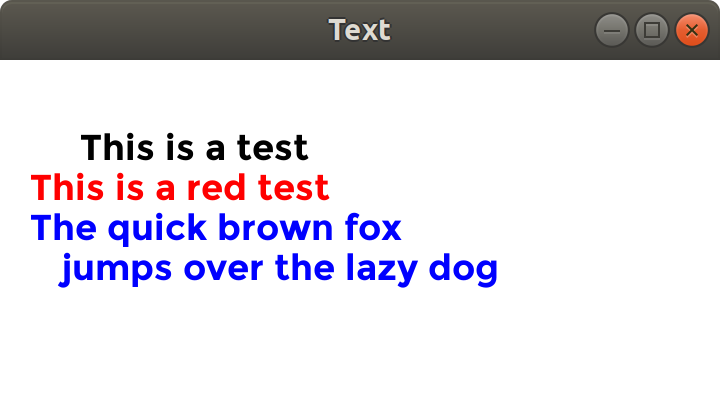Text rendering in Vulkan using FreeType
[vulkan freetype c++ For my Vulkan sprite renderer I decided to use FreeType for text rendering.
Text rendering is essentially drawing character bitmaps, laid out one after another so that they line up, with appropriate spacing. TrueType fonts, however, are defined by straight line segments and quadratic Bézier curves - this is where FreeType comes in, to convert those lines and curves to bitmaps.
Here’s the main loop for my sample app for text rendering:
void TextApp::Run() {
Renderer r;
r.Initialize(m_window, Renderer::ENABLE_VALIDATION);
auto ta = r.CreateTextureAtlas(512, 512);
FontManager fm(ta);
auto font = fm.GetFont("resources/montserrat/Montserrat-Bold.ttf", 36);
r.SetClearColor({1.0f, 1.0f, 1.0f, 1.0f});
while (!glfwWindowShouldClose(m_window)) {
glfwPollEvents();
if(r.StartFrame()) {
r.SetColor({0.0f, 0.0f, 0.0f, 1.0f});
font->Draw(r, 80, 100, "This is a test");
r.SetColor({1.0f, 0.0f, 0.0f, 1.0f});
font->Draw(r, 30, 140, "This is a red test");
r.SetColor({0.0f, 0.0f, 1.0f, 1.0f});
font->Draw(r, 30, 180, "The quick brown fox");
font->Draw(r, 60, 220, "jumps over the lazy dog");
r.EndFrame();
}
}
r.WaitUntilDeviceIdle();
}

The classes
The FontManager class has a GetFont method that returns a shared pointer to a Font. The GetFont method takes two parameters - a path to a font file and the size, in points.
The Font class has a GetGlyph method, returning a Glyph corresponding to a given Unicode character. The Glyph class has a GetTexture method, as well as methods for getting metrics on the glyph, that are used for placing the bitmap when rendering text.
When rendering text on the application level, the Glyph class isn’t used directly, though - the Font class also has the Draw method:
void Font::Draw(Renderer &r, float x, float y, const std::string &text) {
int pos = x;
for(auto c: text) {
auto glyph = GetGlyph(c);
auto texture = glyph->GetTexture();
if(texture) {
r.SetTexture(texture);
float x0 = pos + glyph->GetLeft();
float y0 = y - glyph->GetTop();
r.DrawSprite(x0, y0, texture->GetWidth(), texture->GetHeight());
}
pos += glyph->GetAdvance();
}
}
Note that the bitmaps for different glyphs in a font are not of a uniform size, but rather tightly packed around the pixels needed for each character. An upper-case ‘A’ is much wider than the lower case ‘i’, for example.
A space doesn’t get any bitmap, but it has an advance value that tells us how far to move horizontally. This is why we need the if(texture) check.
The GetLeft and GetTop methods give us the offsets from the x and y positions, to compensate for the different bitmap sizes, and GetAdvance tells us how far to move to position for the next character.
The implementations
The GetFont method on the font manager is a wrapper around FT_New_Face:
std::shared_ptr<Font> FontManager::GetFont(const std::string& fontname, int pt) {
FT_Face face;
auto error = FT_New_Face(m_library, fontname.c_str(), 0, &face);
if(!error) {
error = FT_Set_Pixel_Sizes(face, 0, static_cast<FT_UInt>(pt));
if(error) {
throw std::runtime_error("couldn't set pixel sizes");
}
return std::make_shared<Font>(face, m_textureAtlas);
}
throw std::runtime_error("couldn't load font");
}
The Font::GetGlyph method is a wrapper around FT_Get_Char_Index. It also caches the results, to ensure we’re not getting a new bitmap every time we draw a character. The conversion to a bitmap only needs to happen once per character.
std::shared_ptr<Glyph> Font::GetGlyph(uint16_t c) {
auto foundIt = m_glyphs.find(c);
if(foundIt != m_glyphs.end()) {
return foundIt->second;
}
auto glyphIndex = FT_Get_Char_Index(m_face, c);
auto glyph = std::make_shared<Glyph>(m_face, glyphIndex, m_textureAtlas);
m_glyphs[c] = glyph;
return glyph;
}
The constructor for the Glyph calls FT_Load_Glyph and FT_Render_Glyph, then caches the relevant information about the glyph as well as the bitmap itself:
Glyph::Glyph(FT_Face face, FT_UInt ix, std::shared_ptr<TextureAtlas> ta) : m_face(face), m_glyphIndex(ix) {
auto error = FT_Load_Glyph(m_face, m_glyphIndex, FT_LOAD_DEFAULT);
if(error) {
throw std::runtime_error("failed to load glyph");
}
FT_GlyphSlot glyphSlot = m_face->glyph;
error = FT_Render_Glyph(glyphSlot, FT_RENDER_MODE_NORMAL);
if(error) {
throw std::runtime_error("failed to render glyph");
}
m_left = glyphSlot->bitmap_left;
m_top = glyphSlot->bitmap_top;
m_width = static_cast<int>(glyphSlot->metrics.width / 64);
m_height = static_cast<int>(glyphSlot->metrics.height / 64);
m_advance = static_cast<int>(glyphSlot->advance.x / 64);
CreateTextureFromBitmap(ta);
}
Finally the CreateTextureFromBitmap helper method, that copies the bitmap data from the FreeType buffer to a texture (I’ve taken some shortcuts by only supporting the most common bitmap format):
void Glyph::CreateTextureFromBitmap(std::shared_ptr<TextureAtlas> &ta) {
FT_GlyphSlot glyphSlot = m_face->glyph;
if(glyphSlot->bitmap.pixel_mode != FT_PIXEL_MODE_GRAY || glyphSlot->bitmap.num_grays != 256) {
throw std::runtime_error("unsupported pixel mode");
}
auto width = glyphSlot->bitmap.width;
auto height = glyphSlot->bitmap.rows;
auto bufferSize = width*height*4;
if(bufferSize == 0) {
return;
}
std::vector<uint8_t> buffer(bufferSize);
uint8_t* src = glyphSlot->bitmap.buffer;
uint8_t* startOfLine = src;
int dst = 0;
for(int y = 0; y < height; ++y) {
src = startOfLine;
for(int x = 0; x < width; ++x) {
auto value = *src;
src++;
buffer[dst++] = 0xff;
buffer[dst++] = 0xff;
buffer[dst++] = 0xff;
buffer[dst++] = value;
}
startOfLine += glyphSlot->bitmap.pitch;
}
m_texture = ta->Add(width, height, buffer.data());
}
The bitmap provided by FreeType is an 8-bit grayscale format. I’m using a dynamic texture atlas for all my textures so it is a full 32-bit RGBA format, and this method does the conversion for each pixel to a full white, with the original grayscale value as the alpha component.
Text layout
The Font also has a Measure method, that iterates over the given text in the same way as the Draw, without actually rendering anything, but it returns the dimensions of the text if it were to be rendered:
TextDimensions Font::Measure(const std::string& text) {
int width = 0;
int height = 0;
for(auto c: text) {
auto glyph = GetGlyph(c);
width += glyph->GetAdvance();
height = std::max(height, glyph->GetTop() + glyph->GetHeight());
}
return TextDimensions{width, height};
}
This can be used as the basis for centering the text, for example, or right-aligning.
What’s next?
My simple engine can now render text, but it’s rather rudimentary. At some point I want to do proper text layout so I can render text, with some markup, that changes the type face, font size, with bold and italics, etc.
